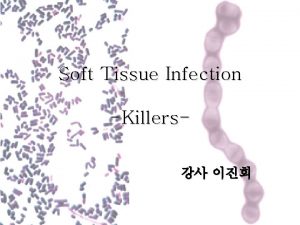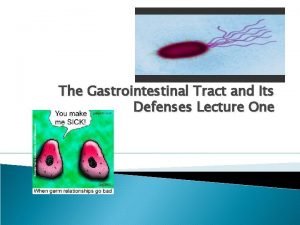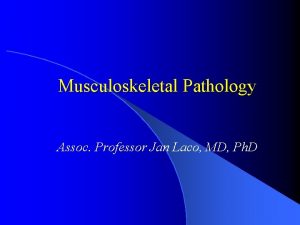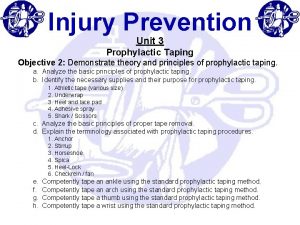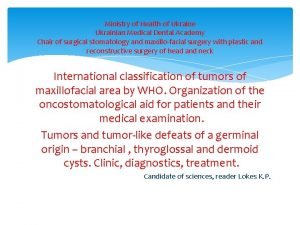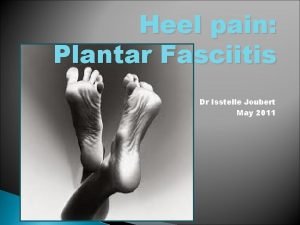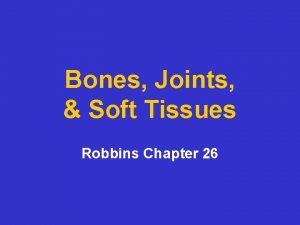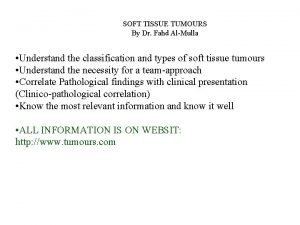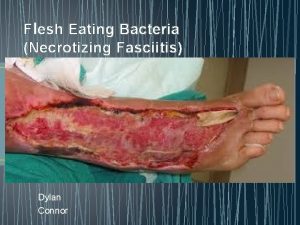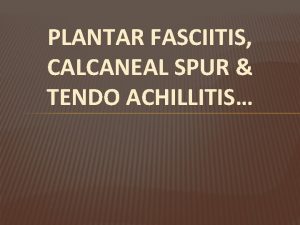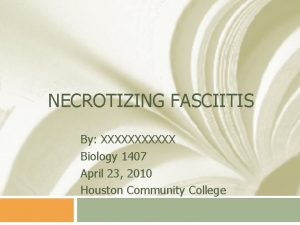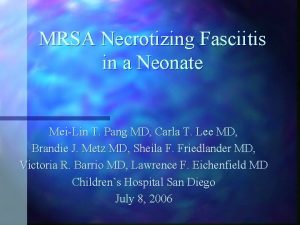Necrotizing Fasciitis Clinical Features Systemic findings such as












- Slides: 12

Necrotizing Fasciitis

Clinical Features • Systemic findings, such as fever, tachycardia, and hypotension • Typical signs and symptoms such as tense edema outside the involved skin, disproportionate pain, blisters/bullae, crepitus, and subcutaneous gas • Antibiotic therapy alone is associated with a mortality rate approaching 100 percent

Two Clinical Types • Type I - a mixed infection caused by aerobic and anaerobic bacteria and occurs most commonly after surgical procedures and in patients with DM and peripheral vascular disease. • Type II - a monomicrobial infection caused by group A streptococcus (GAS, Streptococcus pyogenes).

Type I • Cervical necrotizing fasciitis: "Ludwig's angina, " a rapidly expanding inflammation in the submandibular and sublingual spaces. • Fournier's gangrene: In the perineal area, penetration of the GI or urethral mucosa by enteric organisms can cause Fournier's gangrene, an aggressive infection.

Type II • Most cases were community-acquired but 20 % were nosocomial or acquired in a nursing home. • type II can occur in any age group and among patients who do not have complicated medical illnesses.

• Predisposing factors include a history of blunt trauma, varicella (chickenpox), injection drug use, a penetrating injury such as laceration, surgical procedures, childbirth, exposure to a "case, " burns, and perhaps NSAID.

Diagnosis • Must be distinguished from gas gangrene, pyomyositis, and myositis. • Blood tests typically demonstrate a leukocytosis with a marked left shift, and elevations in the serum creatine kinase and creatinine concentrations. • Imaging - Soft tissue x-rays, CT scan and MRI


Treatment • Early and aggressive surgical exploration and debridement of necrotic tissue. The best indication for surgical intervention is severe pain, toxicity, fever and elevated CPK with or without radiographic findings. • Antibiotic therapy • Hemodynamic support as needed

Antibiotic therapy – Type I • Early empiric treatment could include ampicillin or ampicillin-sulbactam combined with either clindamycin or metronidazole. • G(-) coverage - substituting ticarcillinclavulanate or piperacillin-tazobactam for ampicillin-sulbactam or by adding a fluoroquinolone, an aminoglycoside, an extended spectrum cephalosporin, or a carbapenem.

Antibiotic therapy – Type II • penicillin G (4 million units IV every four hours in adults >60 kg in weight and with normal renal function) in combination with clindamycin

Mortality Rate • The mortality rates in different studies have included 21 % in type I necrotizing fasciitis , 30 and 34 % in type II necrotizing fasciitis in which streptococcal toxic shock syndrome is commonly associated with mortality in patients with GAS infection , 22 % in patients with cervical necrotizing fasciitis , and 22 to 40 % in those with Fournier's gangrene.
 Necrotizing fasciitis hemorrhagic bullae
Necrotizing fasciitis hemorrhagic bullae Necrotizing ulcerative gingivitis
Necrotizing ulcerative gingivitis Indication for exploratory laparotomy
Indication for exploratory laparotomy What is nec in babies
What is nec in babies Translating research findings to clinical nursing practice
Translating research findings to clinical nursing practice Nodular fasciitis
Nodular fasciitis What is the purpose of prophylactic taping?
What is the purpose of prophylactic taping? Kt tape elbow hyperextension
Kt tape elbow hyperextension Nodular fasciitis
Nodular fasciitis Plantar fasciitis betekenis
Plantar fasciitis betekenis Dr eric berg plantar fasciitis
Dr eric berg plantar fasciitis Nodular fasciitis
Nodular fasciitis Nodular fasciitis
Nodular fasciitis
